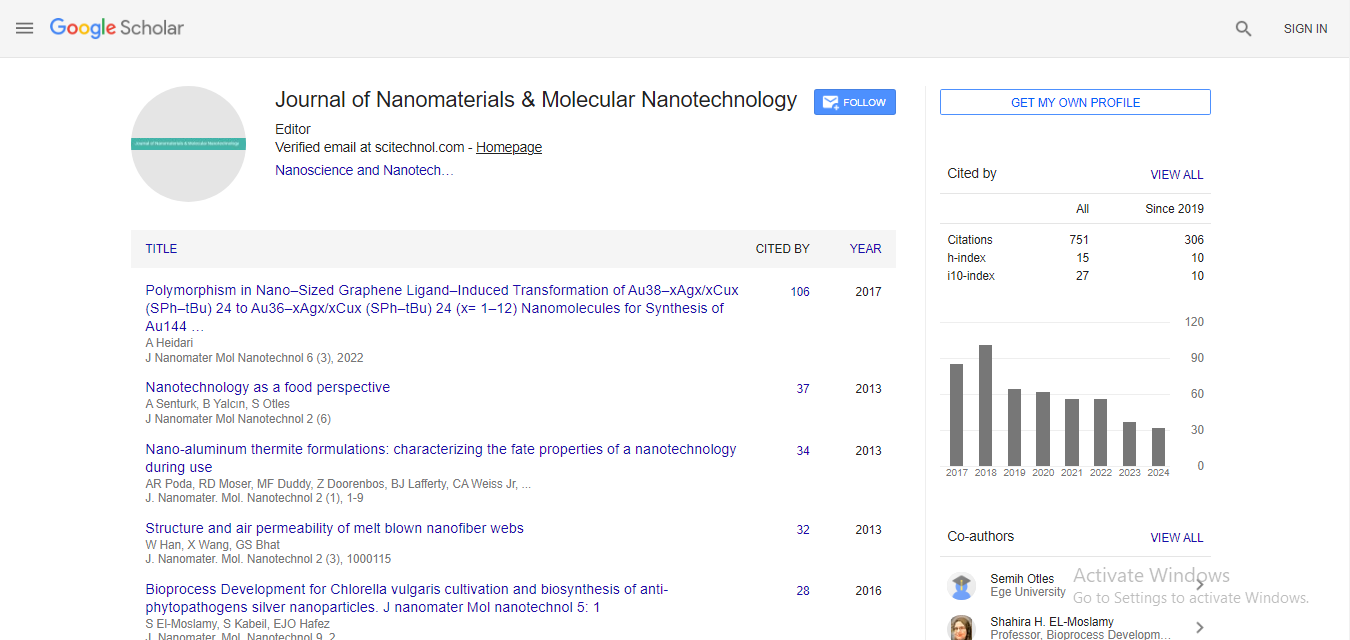Perspective, J Nanomater Mol Nanotechnol Vol: 13 Issue: 6
Nanodevices in Environmental Monitoring: Towards Smarter Sensors
Kazantsev Tarasov*
1Department of Material Science, National Research Tomsk State University, Tomsk, Russia
*Corresponding Author: Kazantsev Tarasov,
Department of Material Science,
National Research Tomsk State University, Tomsk, Russia
E-mail: kazant.sov@nrtsu.ru
Received date: 22 November, 2024, Manuscript No. JNMN-24-156145;
Editor assigned date: 25 November, 2024, PreQC No. JNMN-24-156145 (PQ);
Reviewed date: 09 December, 2024, QC No. JNMN-24-156145;
Revised date: 16 December, 2024, Manuscript No. JNMN-24-156145 (R);
Published date: 24 December, 2024, DOI: 10.4172/2324-8777.1000447
Citation: Tarasov K (2024) Nanodevices in Environmental Monitoring: Towards Smarter Sensors. J Nanomater Mol Nanotechnol 13:6.
Description
Environmental monitoring is major for ensuring public health and protecting ecosystems from the harmful effects of pollution. Traditional monitoring methods, although effective, often lack the sensitivity, portability and real-time data capabilities required for comprehensive environmental surveillance. Nanodevices, with their unique properties at the nanoscale, such as high surface area, enhanced reactivity and quantum effects, have developed as powerful tools for overcoming these limitations. By incorporating nanomaterials like Carbon Nano Tubes (CNTs), graphene, metal nanoparticles and quantum dots into sensor platforms, researchers are developing highly sensitive and selective devices that can monitor a wide range of environmental parameters in real time.
Air pollution is one of the leading environmental health risks globally. Conventional air quality sensors often struggle with sensitivity, specificity and the ability to detect low concentrations of pollutants. Nanodevices, however, offer enhanced performance for detecting gases and particulate matter with high sensitivity. For example, Carbon NanoTubes (CNTs) and graphene-based sensors are at the front line of air quality monitoring. CNTs have been shown to exhibit excellent conductivity changes when exposed to gas molecules, making them ideal for detecting hazardous gases like Carbon monoxide (CO), Nitrogen Dioxide (NO₂) and Volatile Organic Compounds (VOCs) at low concentrations. Graphene, with its high surface area and excellent electrical properties, has also been utilized in sensors for detecting air pollutants with enhanced sensitivity and rapid response times.
Water contamination, including the presence of heavy metals, pathogens and chemical pollutants, remains a major concern for public health and environmental sustainability. Traditional water quality testing often requires large sample volumes and complex, timeconsuming processes. Nanodevices, with their ability to detect contaminants at ultra-low concentrations, offer a promising solution for rapid, on-site water monitoring.
Nanosensors based on materials like gold nanoparticles, silica nanoparticles and carbon quantum dots have been shown to exhibit excellent sensitivity for detecting pollutants such as lead (Pb²⁺), mercury (Hg²⁺) and arsenic (As³⁺). These materials interact with specific ions or molecules, causing a measurable change in optical or electrical properties, which can be detected using simple, portable devices. For instance, gold nanoparticle-based sensors can change color upon binding with heavy metal ions, providing a visual indication of contamination.
In addition to heavy metals, nanodevices can also be designed to detect waterborne pathogens such as E. coli and other bacteria. Functionalized nanoparticles can selectively bind to microbial cells, causing detectable changes in fluorescence or electrical signals, thus enabling rapid pathogen detection in water. Soil health is fundamental for agricultural productivity and ecosystem balance. Monitoring soil quality, including parameters such as pH, nutrient levels and the presence of toxic substances, is essential for sustainable land management. Traditional soil testing is often labor-intensive and requires expensive equipment, limiting its use for real-time monitoring.
There are several challenges associated with the development and utilization of nanodevices in environmental monitoring. One of the primary challenges is the scalability of nanomaterials. While nanodevices have demonstrated high sensitivity in laboratory settings, translating these results into large-scale, commercially viable sensors is a complex process. Manufacturing techniques must be developed that can produce these devices consistently and cost-effectively. The future of nanodevice-based environmental sensors is favorable, with ongoing research focusing on improving their performance, scalability and environmental safety. Innovations in nanomaterial synthesis, sensor integration and data analytics are likely to lead to the development of smarter, more efficient environmental monitoring systems. Moreover, the combination of nanodevices with developing technologies such as the Internet of Things (IoT) and Artificial Intelligence (AI) holds the potential to create real-time, autonomous monitoring networks capable of providing continuous environmental data on a global scale.
Conclusion
Nanodevices are prepared to revolutionize environmental monitoring by offering more sensitive, efficient and portable sensors for air, water and soil quality. While challenges remain in terms of scalability, stability and environmental safety, the continued development of nanodevice-based sensors potentials to enhance our ability to monitor and protect the environment more effectively. As technology advances, nanodevices will play an increasingly major role in building smarter, sustainable systems for environmental protection and management.
 Spanish
Spanish  Chinese
Chinese  Russian
Russian  German
German  French
French  Japanese
Japanese  Portuguese
Portuguese  Hindi
Hindi 



